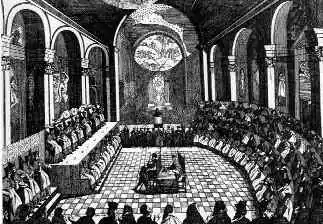Council of Rome
The Council of Rome was a meeting of Catholic Church officials and theologians which took place in 382 under the authority of Pope Damasus I, the then current bishop of Rome. It was one of the fourth century councils that "gave a complete list of the canonical books of both the Old Testament and the New Testament."[1]
| Part of a series on |
| Ecumenical councils of the Catholic Church |
|---|
 |
| Antiquity (c. 50 – 451) |
| Early Middle Ages (553–870) |
| High and Late Middle Ages (1122–1517) |
| Modernity (1545–1965) |
|
|
The previous year, the Emperor Theodosius I had appointed the "dark horse" candidate Nectarius as Archbishop of Constantinople. The bishops of the West opposed the election result and asked for a common synod of East and West to settle the succession of the see of Constantinople, and so the Emperor Theodosius, soon after the close of the First Council of Constantinople in 381, summoned the Imperial bishops to a fresh synod at Constantinople; nearly all of the same bishops who had attended the earlier second re assembled again in early summer of 382. On arrival they received a letter from the synod of Milan, inviting them to a great general council at Rome; they indicated that they must remain where they were, because they had not made any preparations for such long a journey; however, they sent three—Syriacus, Eusebius, and Priscian—with a joint synodal letter to Pope Damasus, Ambrose, archbishop of Milan, and the other bishops assembled in the council at Rome.
Decretum Gelasianum and damasine
The Decree of the Council of Rome (AD 382) on the Canon of Scripture during the reign of Pope Damasus I (AD 366–384) reads thus:
Now indeed we must treat of the divine Scriptures, what the universal Catholic Church accepts and what she ought to shun. The order of the Old Testament begins here: Genesis one book, Exodus one book, Leviticus one book, Numbers one book, Deuteronomy one book, Josue Nave one book, Judges one book, Ruth one book, Kings four books, Paralipomenon [i.e. Chronicles] two books, Psalms one book, Solomon three books, Proverbs one book, Ecclesiastes one book, Canticle of Canticles one book, likewise Wisdom one book, Ecclesiasticus [i.e. Sirach] one book.
Likewise the order of the Prophets. Isaias one book, Jeremias one book, with Ginoth, that is, with his Lamentations, Ezechiel one book, Daniel one book, Osee one book, Amos one book, Micheas one book, Joel one book, Abdias one book, Jonas one book, Nahum one book, Habacuc one book, Sophonias one book, Aggeus one book, Zacharias one book, Malachias one book. Likewise the order of the histories. Job one book, Tobias one book, Esdras two books [i.e. Ezra & Nehemiah], Esther one book, Judith one book, Machabees two books.
Likewise the order of the writings of the New and Eternal Testament, which only the holy and Catholic Church supports. Of the Gospels, according to Matthew one book, according to Mark one book, according to Luke one book, according to John one book.
The Epistles of Paul the Apostle in number fourteen. To the Romans one, to the Corinthians two, to the Ephesians one, to the Thessalonians two, to the Galatians one, to the Philippians one, to the Colossians one, to Timothy two, to Titus one, to Philemon one, to the Hebrews one.
Likewise the Apocalypse of John, one book. And the Acts of the Apostles one book. Likewise the canonical epistles in number seven. Of Peter the Apostle two epistles, of James the Apostle one epistle, of John the Apostle one epistle, of another John, the presbyter, two epistles, of Jude the Zealut, the Apostle one epistle.[2]
The Oxford Dictionary of the Christian Church, states:[1]
A council probably held at Rome in 382 under St. Damasus gave a complete list of the canonical books of both the Old Testament and the New Testament (also known as the 'Gelasian Decree' because it was reproduced by Gelasius in 495), which is identical with the list given at Trent.
Catholic apologist and historian William Jurgens writes:[3]
The first part of this decree has long been known as the Decree of Damasus, and concerns the Holy Spirit and the seven-fold gifts. The second part of the decree is more familiarly known as the opening part of the Gelasian Decree, in regard to the canon of Scripture: De libris recipiendis vel non recipiendis. It is now commonly held that the part of the Gelasian Decree dealing with the accepted canon of Scripture is an authentic work of the Council of Rome of 382 A.D. and that Gelasius edited it again at the end of the fifth century, adding to it the catalog of the rejected books, the apocrypha. It is now almost universally accepted that these parts one and two of the Decree of Damasus are authentic parts of the Acts of the Council of Rome of 382 A.D. (Jurgens, Faith of the Early Fathers)
References
- Cross, F. L.; Livingstone, E. A., eds. (2005-01-01). "canon of Scripture". The Oxford Dictionary of the Christian Church (3 ed.). Oxford University Press. p. 282. doi:10.1093/acref/9780192802903.001.0001. ISBN 978-0-19-280290-3.
- "Decree of Council of Rome (AD 382) on the Biblical Canon". Taylor Marshall. August 19, 2008.
- The faith of the early fathers : a source-book of theological and historical passages ... 1. Jurgens, W. A. Collegeville, Minn.: Liturgical Press. 1970–1979. p. 404. ISBN 0-8146-0432-3. OCLC 5256138.CS1 maint: others (link)
Further reading
- Geoffrey Mark Hahneman, The Muratorian Fragment and the Development of the Canon, Oxford University Press, 1992 - pages 158−161 ISBN 9780198263418